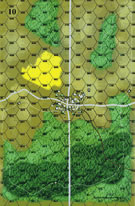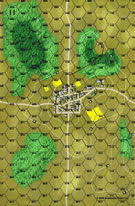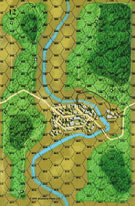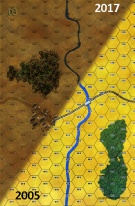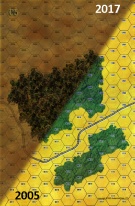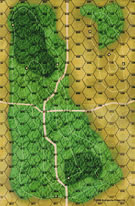| Author |
Schoenwulf
|
| Method |
Solo |
| Victor |
Finland |
| Play Date |
2018-10-29 |
| Language |
English |
| Scenario |
AFDx020
|
On the morning of September 21, 1941, Finnish units from the 1st Jäger Brigade and Tank Battalion moved forward to clear the area around the Svir River. At 0730 hours, they encountered units from the Soviet 3rd NKVD Border Regiment in both the fields south of the river and woods further south. An intense skirmish in the southern woods took a toll on a couple of the Finnish platoons, while others continued to move east toward the town of Latva. Finnish units also advanced on the town from the north and took fire from both mortars and an armored train. By 0930 hours, Sisu platoons were in the woods west of the town and eliminating limited Soviet resistance there. Shortly after 1000 hours, a captured Finnish unit using captured T-34’s moved close enough to fire and eliminate the Soviet armored train. By midday, the Sisu had Latva surrounded and were clearing Soviet units within the town itself, although spirited fighting continued from house to house. Meanwhile, a small group of Soviet units west of town were holding their own and eliminated a T-26s platoon. The town was secured by Finnish troops shortly before 1300 hours, and the only remaining Soviet unit were in the west woods attempting to form a fire group. All Soviet units were eliminated or captured by 1415 hours and the Finnish units had taken the day.
This scenario has complex objectives and is played over a six-map battlefield. The Finnish forces receive VP’s for town & bridge control and Soviet steps eliminated. The Soviets have similar objectives but can also gain VP’s for Soviet units that exit the board if certain parameters have been met. The Soviet setup forces placement of units over 4 different maps, so initial setup involved Soviets set up in the field on Map 12, southeast woods on Map 9, dug-in south of the river, in town and in the woods both west and south of town on Maps 3 and 6. The Finns entered north and south of the river on Maps 11 & 12 with armor split between both forces, and in the woods east (HMG’s + INF) and west (mortars + INF) of the railroad embankment on Map 10. The first two turns were shortened by fog-of-war, so it took both turns to get all Finnish forces in play. Both sides had several “kill” die rolls, but the Finnish benefitted the most when a single “12” eliminated the Soviet armored train for double VP’s. The superior morale, movement advantage of the Sisu and armor, and the sheer number of Finnish forces eventually locked in and eliminated the Soviet resistance. All Soviet units were eliminated with a loss of 12 Finnish steps for a 71-12 VP Major Victory for the Finns.
This is a tough one for the Soviet player. Although historically, the armored train covered a move north for some of the Soviet troops to escape, in this scenario the Soviets can’t “break out” until they have lost 15 steps, and they were down 18-4 on the turn that occurred. There are 51 Soviet steps in the game, and the town and bridge are worth 20 VP’s to either side; thus, at the “breakout point”, the score would have been 38-4 in the Finns favor. So, even if all Soviet units (33 steps) could leave the terrain VP’s behind and exit the board, it made little sense to try and evacuate as that would have only made a draw possible at 38-37 VP’s. In addition, the chances of all Soviet units getting through the Finnish juggernaut would have been extremely slim, and a shift of eight steps would have cemented the Finnish victory. The Finnish strategy used in this scenario would seem to work against either Soviet approach, stand-and-fight or breakout-withdrawal. For the Soviets, the player could either attempt to defend the bridge and town or move forces close to the northern border as quickly as possible hoping to overwhelm the Finnish forces that enter from there; if that were successful, some Soviet units could then move south to attempt to secure the town. The bottom line is that you want a challenge, try the Soviets; or take the Finns for a good chance to win.
One rule change that I would made if I developed this scenario would be to give the Sotka hidden movement, as it is supposed to be masquerading as a T-34; however, as the rules are currently written, it only remains undiscovered until adjacent to a Soviet unit or firing at one. With the current rules, the Soviet player can quickly move the armored train from the T-34 as s/he knows the location of the chit. This probably wasn't done since such a change would add even greater imbalance to the scenario.
|








 AFDx019
AFDx019 



